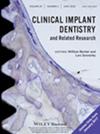Can Reimplantation Be Performed After Peri-Implant Recurrent Pyogenic Granuloma Leads to Implant Failure? A Case Report
Abstract
Background
Peri-implant pyogenic granuloma (PG) is a benign vascular lesion associated with dental implants, typically resulting from local irritation. While peri-implant PG can ultimately lead to implant failure, there is no established consensus regarding the feasibility of reimplantation after implant removal.
Case Report
A 66-year-old female patient presented to the clinic with painful erythematous and swollen gingiva in the left posterior maxillary region, accompanied by a bleeding tendency. The patient had received two titanium alloy implants in the same area 7 and 3 years ago, respectively, for missing posterior teeth. Clinical examination revealed soft tissue hyperplasia and easy bleeding upon touch around the implants supporting the prosthetic restoration at Sites 24 and 25. Radiographic evaluation showed no significant bone resorption. Initial management included the prosthetic restoration removal, placement of healing abutments, and peri-implant curettage with the application of medication. After 10 days, the lesion was surgically excised, and histopathological analysis confirmed the diagnosis of PG. Despite initial treatment, the lesion recurred 2 weeks after excision. A second excision, coupled with debridement and local medication, was performed. However, the PG recurred 3 weeks later, necessitating the implants removal at sites 24 and 25. Following implants removal, the surgical sites were monitored for 3 months, during which no PG recurrence was observed. Given the patient's systemic health and the local soft and hard tissue conditions, the tooth at site 26, which had a poor prognosis, was also extracted. Subsequently, reimplantation was performed at sites 24, 25, and 26. After a six-month healing period, the prosthetic restoration was completed. Three and six months post-restoration, clinical and radiographic evaluations confirmed stable outcomes, with no abnormalities in the peri-implant soft or hard tissues.
Conclusion
Peri-implant PG is a relatively rare soft tissue complication associated with dental implants and is characterized by a high recurrence rate, often leading to implant removal. This case illustrates successful reimplantation at the original site following implant removal due to PG, providing clinical evidence that reimplantation after PG-related implant failure is feasible. However, a thorough evaluation of both systemic and local factors is essential to minimize recurrence and ensure successful outcomes.

 求助内容:
求助内容: 应助结果提醒方式:
应助结果提醒方式:


